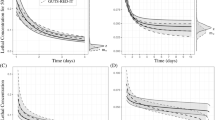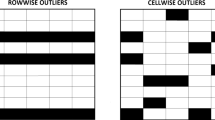Abstract
The assessment of the ecological risk of chemical contamination by pollutants, pesticides or toxicants is of primary interest in environmental statistics. Concentration-response models play a fundamental role in computing the risk values connected with some exposure levels of a particular contaminant in living organisms. The present paper proposes a regression model called simplicial regression. This model is able to cope with the relative character of the explanatory and response parts via the logratio methodology of compositional data. Consequently, it allows performance of the corresponding statistical inference under the assumption of normality. Some real-world examples show that simplicial regression even outperforms the existing well-established methodologies on standard accuracy and quality-of-fit criteria. The better fit is due to the change of scale entailed by the new model.


Similar content being viewed by others
References
Aitchison J (1986) The statistical analysis of compositional data. Chapman & Hall, London
Backhaus T, Altenburger R, Boedeker W, Faust M, Scholze M, Grimme LH (2000) Predictability of the toxicity of a multiple mixture of dissimilarly acting chemicals to Vibrio fischeri. Environ Toxicol Chem 19:2348–2356
Backhaus T, Froehner K, Altenburger R, Grimme LH (1997) Toxicity testing with Vibrio fischeri: a comparison between the long term (24 h) and the short term (30 min) bioassay. Chemosphere 35:2925–2938
Burnham KP, Anderson DR (2002) Model selection and multimodel inference: a practical information-theoretic approach, 2nd edn. Springer, New York
Casella G, Berger RL (2007) Statistical inference, 2nd edn. Duxbury Press (Thomson Learning Academic Resource Center), Pacific Grove
Cribari-Neto F, Zeileis A (2010) Beta regression in R. J Stat Softw 34(2):1–24
Davidian M, Carroll RJ, Smith W (1988) Variance functions and the minimum detectable concentration in assays. Biometrika 75:549–556
EFSA (2005) Opinion of the scientific panel on plant health, plant protection products and their residues on a request from EFSA related to the assessment of the acute and chronic risk to aquatic organisms with regard to the possibility of lowering the uncertainty factor if additional species were tested. EFSA J 301:1–45 (2005)
Egozcue JJ, Daunis-i-Estadella J, Pawlowsky-Glahn V, Hron K, Filzmoser P (2011) Simplicial regression, the normal model. J Appl Probab Stat 6:87–108
Egozcue JJ, Pawlowsky-Glahn V (2006) Simplicial geometry for compositional data. In: Buccianti A, Mateu-Figueras G, Pawlowsky-Glahn V (eds) Compositional data analysis in the geosciences: from theory to practice. Geological Society, London, pp 145–160
Egozcue JJ, Pawlowsky-Glahn V, Mateu-Figueras G, Barceló-Vidal C (2003) Isometric logratio transformations for compositional data analysis. Math Geol 35:279–300
Environment Canada. Guidance document on statistical methods for environmental toxicity tests. Report EPS /RM/46. Ottawa, ON (2005)
Ferrari S, Cribari-Neto F (2004) Beta regression for modelling rates and proportions. J Appl Stat 31:799–815
Filzmoser P, Hron K, Reimann C (2009) Univariate statistical analysis of environmental (compositional) data: Problems and possibilities. Sci Total Environ 407:6100–6108
Finney DJ (1979) Bioassay and the practice of statistical inference. Int Stat Rev 47:1–12
Hron K, Templ M, Filzmoser P (2013) Estimation of a proportion in survey sampling using the logratio approach. Metrika 76:799–818
Kieschnick R, McCullough BD (2003) Regression analysis of variates observed on (0,1): percentages, proportions and fractions. Stat Model 3:193–213
Long JS (1997) Regression models for categorical and limited dependent variables. Sage, London
Martín-Fernández JA, Palarea-Albaladejo J, Olea RA (2011) Dealing with zeros. In: Pawlowsky-Glahn V, Buccianti A (eds) Compositional data analysis: theory and applications. Wiley, Chichester, pp 43–58
Mateu-Figueras G, Pawlowsky-Glahn V (2008) A critical approach to probability laws in geochemistry. Math Geosci 40:489–502
Mateu-Figueras G, Pawlowsky-Glahn V, Egozcue JJ (2011) The principle of working on coordinates. In: Pawlowsky-Glahn V, Buccianti A (eds) Compositional data analysis: theory and applications. Wiley, Chichester, pp 31–42
McCullagh P, Nelder JA (1989) Generalized linear models, 2nd edn. Chapman & Hall, London
Montgomery DC, Peck EA, Vining GG (2001) Introduction to linear regression analysis, 4th edn. Wiley, Hoboken
Morgan BJT (1992) Analysis of quantal response data: monographs on statistics and applied probability. Chapman & Hall/CRC, london
Organization for Economic Cooperation and Development (2006) Current approaches in the statistical analysis of ecotoxicity data: a guidance to application. Chapter 6. Paris, France, pp 62–102
Pawlowsky-Glahn V, Buccianti A (2011) Compositional data analysis: theory and applications. Wiley, Chichester
R Core Team (2012) R: a language and environment for statistical computing. R Foundation for Statistical Computing, Vienna
Ripley BD (1996) Pattern recognition and neural networks. Cambridge University Press, Cambridge
Ritz Ch (2010) Toward a unified approach to dose-response modeling in ecotoxicology. Environ Toxicol Chem 29:220–229
Scholze M, Boedeker W, Faust M, Backhaus T, Altenburger R, Grimme LH (2001) A general best-fit method for concentration-response curves and the estimation of low-effect concentrations. Environ Toxicol Chem 20:448–457
Seber GAF, Wild CJ (2005) Nonlinear regression, Series in probability and statistics. Wiley, New York
Stroup WW (2012) Generalized linear mixed models: modern concepts, methods and applications. CRC Press, Boca Raton
Tolosana-Delgado R, van den Boogaart KG (2011) Linear models with compositions in R. In: Pawlowsky-Glahn V, Buccianti A (eds) Compositional data analysis: theory and applications. Wiley, Chichester, pp 356–371
van den Boogaart KG, Tolosana-Delgado R (2013) Analyzing compositional data with R. Springer, Heidelberg
Venables WN, Ripley BD (2002) Modern applied statistics with S. Springer, New York
Vighi M, Migliorati S, Monti GS (2009) Toxicity on the luminescent bacterium Vibrio fischeri (Beijerinck). I: QSAR equation for narcotics and polar narcotics. Ecotoxicol Environ Saf 72:154–161
Acknowledgments
Research partially financially supported by the Italian Ministry of University and Research, FAR (Fondi di Ateneo per la Ricerca) 2011. The authors also gratefully acknowledge the support of both the Operational Program Education for Competitiveness—European Social Fund (Project CZ.1.07/2.3.00/20.0170 of the Ministry of Education, Youth and Sports of the Czech Republic) and the grant IGA_PrF_2014_028 Mathematical Models of the Internal Grant Agency of the Palacký University in Olomouc. The authors are grateful to Professor Marco Vighi who has kindly permitted the elaboration of the Vibrio fischeri (Beijerinck) data set.
Author information
Authors and Affiliations
Corresponding author
Additional information
Handling Editor: Bryan F. J. Manly.
Appendix: Supporting information
Appendix: Supporting information
Supplementary data associated with this article concern other non-polar and polar narcotics datasets.
See Figs. 3, 4, 5 and 6 and Tables 7, 8, 9, 10, 11 and 12.
Rights and permissions
About this article
Cite this article
Monti, G.S., Migliorati, S., Hron, K. et al. Log-ratio approach in curve fitting for concentration-response experiments. Environ Ecol Stat 22, 275–295 (2015). https://doi.org/10.1007/s10651-014-0298-z
Received:
Revised:
Published:
Issue Date:
DOI: https://doi.org/10.1007/s10651-014-0298-z








